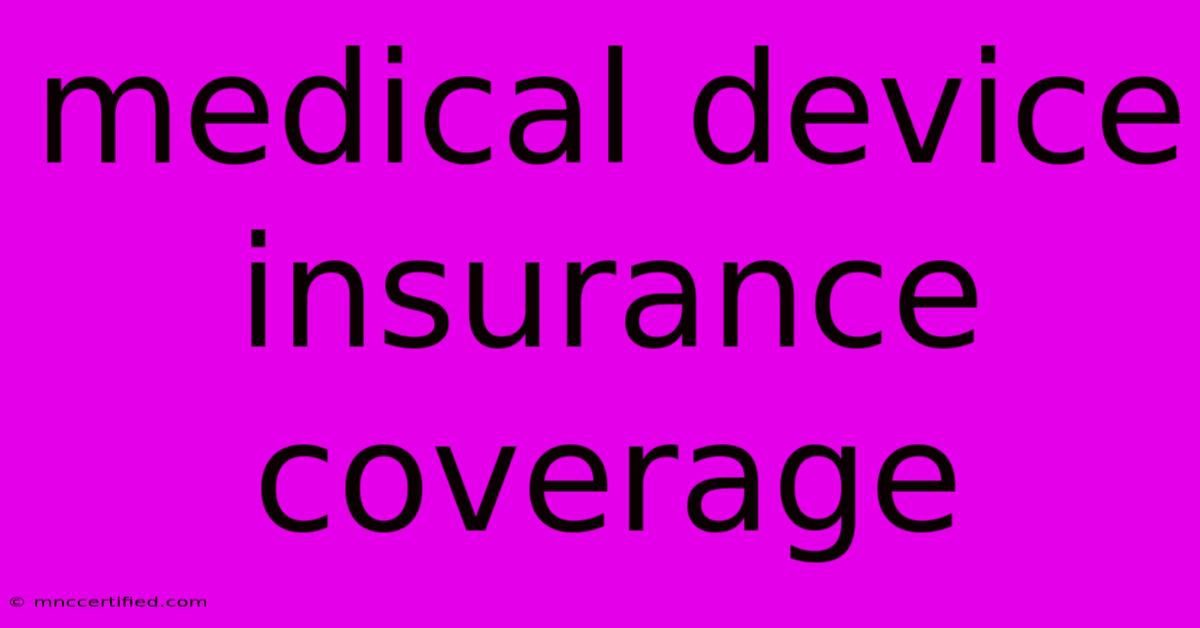Medical Device Insurance Coverage

Table of Contents
Navigating the Maze: Understanding Medical Device Insurance Coverage
Medical devices are increasingly crucial in managing and improving health outcomes, but their costs can be substantial. Understanding your insurance coverage for these devices is vital to avoid unexpected financial burdens. This comprehensive guide breaks down the complexities of medical device insurance coverage, helping you navigate the process effectively.
What is Considered a Medical Device?
Before diving into coverage specifics, it's important to define what constitutes a medical device. The FDA broadly defines medical devices as instruments, apparatus, implements, machines, contrivances, implant materials, or other similar or related articles, including any component, part, or accessory, which are intended for use in the diagnosis of disease or other conditions, or in the cure, mitigation, treatment, or prevention of disease, in man or other animals. This encompasses a vast range of items, from simple bandages to sophisticated implantable devices.
Types of Medical Device Insurance Coverage
Insurance coverage for medical devices varies greatly depending on several factors, including:
- Your insurance plan: Different plans (Medicare, Medicaid, private insurance) have varying levels of coverage. Some plans may require pre-authorization for specific devices.
- The type of device: High-cost devices like pacemakers or prosthetic limbs often have more stringent coverage requirements than simpler devices.
- Medical necessity: Your doctor must demonstrate the medical necessity of the device for your specific condition. This usually involves providing documentation supporting the diagnosis and the device's role in treatment.
- The manufacturer and model: Certain manufacturers or models may be preferred by your insurer, influencing coverage decisions.
Medicare Coverage for Medical Devices
Medicare coverage for medical devices is complex and depends on the specific device and your Medicare plan (Part A, Part B, or a Medicare Advantage plan). Generally, Medicare covers medically necessary devices when used in conjunction with covered services. However, there might be limitations on specific brands or models.
Medicaid Coverage for Medical Devices
Medicaid coverage also varies widely by state. While generally covering medically necessary devices, specific criteria and pre-authorization procedures will differ. Contact your state Medicaid agency for detailed information.
Private Insurance Coverage for Medical Devices
Private insurance plans have their own coverage policies regarding medical devices. It's crucial to review your policy's benefit booklet or contact your insurance provider to understand what's covered, what's not, and any pre-authorization processes.
Key Factors Influencing Coverage
Several factors beyond the type of insurance can impact your coverage:
- Pre-authorization: Many insurers require pre-authorization for specific medical devices, often involving submitting documentation to justify the need for the device before it's purchased or implanted. Failure to obtain pre-authorization can lead to denied claims.
- Durable Medical Equipment (DME): Many medical devices fall under the category of Durable Medical Equipment (DME). Understanding DME coverage within your plan is crucial.
- Appeals process: If your claim is denied, understand your insurer's appeals process. You may have the right to appeal the decision with additional documentation.
- Out-of-pocket costs: Even with insurance coverage, you'll likely face out-of-pocket expenses like deductibles, co-pays, and coinsurance.
Tips for Maximizing Your Medical Device Coverage
- Review your insurance policy: Thoroughly review your policy documents to understand your coverage for medical devices.
- Obtain pre-authorization: If required, submit all necessary documentation well in advance to avoid delays.
- Choose in-network providers: Using in-network providers can often lead to lower costs and simplified billing.
- Keep detailed records: Maintain thorough records of all communication with your insurer, including claims, denials, and appeals.
- Seek professional help: Consider consulting a healthcare advocate or financial advisor if you're facing difficulties navigating the complexities of medical device insurance.
Conclusion: Proactive Planning is Key
Navigating the world of medical device insurance coverage can be challenging, but proactive planning and thorough understanding of your policy are essential. By familiarizing yourself with the key factors influencing coverage and following the tips outlined above, you can significantly improve your chances of securing the necessary financial support for your medical needs. Remember, always consult with your doctor and insurance provider to address any specific concerns related to your individual situation.

Thank you for visiting our website wich cover about Medical Device Insurance Coverage. We hope the information provided has been useful to you. Feel free to contact us if you have any questions or need further assistance. See you next time and dont miss to bookmark.
Featured Posts
-
Amber Alert Canceled Kids Safe In Stoughton
Nov 23, 2024
-
Dee Devlins Demure Court Look
Nov 23, 2024
-
New Movie Wickeds Uk Ireland Opening
Nov 23, 2024
-
Young Men At Risk Ringworm Warning
Nov 23, 2024
-
Return To Paradise Characters In Death In Paradise
Nov 23, 2024